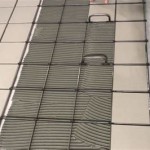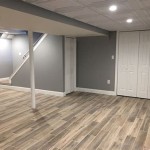Laying Vinyl Flooring Over Asbestos Tile: A Comprehensive Guide
The decision to lay new vinyl flooring over existing asbestos-containing floor tiles is a common scenario for homeowners seeking to update their interiors while managing the complexities of asbestos abatement. Asbestos floor tiles, typically 9x9 inch squares, were widely used in residential and commercial construction from the 1920s until the 1980s. While undisturbed asbestos poses minimal risk, disturbing it during removal can release harmful fibers into the air. Consequently, encapsulation – covering the asbestos tile with a new layer of flooring – is often considered a safer and more cost-effective alternative to complete removal.
This article provides a detailed overview of the process, considerations, and best practices involved in laying vinyl flooring over asbestos tile, emphasizing safety, preparation, installation, and long-term management. It is crucial to understand that this approach is not without its risks, and adhering to regulations and guidelines is paramount.
Understanding the Risks and Regulations
Asbestos, a naturally occurring mineral, was prized for its heat resistance, tensile strength, and insulating properties. However, prolonged exposure to airborne asbestos fibers is linked to serious health problems, including asbestosis, lung cancer, and mesothelioma. While asbestos floor tiles generally contain a small percentage of asbestos fibers bound within a durable matrix, improper handling and removal can release these fibers into the air, posing a health hazard.
Federal regulations, primarily under the jurisdiction of the Environmental Protection Agency (EPA) and the Occupational Safety and Health Administration (OSHA), govern the handling and removal of asbestos-containing materials (ACM). These regulations are designed to protect both workers and the public from asbestos exposure. State and local regulations may further supplement federal guidelines, and understanding these local requirements is essential before undertaking any project involving asbestos-containing materials.
In many jurisdictions, disturbing more than a specified amount of asbestos-containing material requires a licensed asbestos abatement contractor. Even if the project falls below the threshold requiring professional abatement, it is highly recommended to consult with a qualified asbestos inspector or contractor to assess the condition of the existing tiles and determine the safest course of action. This professional assessment will provide valuable insights into the potential risks and help develop a comprehensive plan to minimize fiber release.
The primary risk in laying vinyl flooring over asbestos tiles lies in the potential for disturbing the existing tiles. For example, using excessive force during preparation, such as forcefully scraping or sanding the tiles, can release fibers. Additionally, any future renovations or demolition work that disrupts the encapsulated tiles could also pose a risk. Therefore, careful planning, meticulous execution, and clear communication about the presence of asbestos are essential components of this project.
Preparing the Surface for Vinyl Flooring
Proper surface preparation is crucial for the successful installation of vinyl flooring over asbestos tile. A smooth, level, and stable subfloor is essential to prevent telegraphing, which is the transfer of imperfections from the underlying surface to the new flooring. Telegraphing can result in visible bumps, indentations, or unevenness in the finished floor, detracting from its appearance and durability.
The first step is a thorough inspection of the existing asbestos tiles. Look for loose, cracked, or damaged tiles. Any loose tiles should be carefully secured using an appropriate adhesive recommended for asbestos-containing materials. Avoid breaking or damaging the tiles during this process. Cracked or damaged tiles should be addressed with a patching compound specifically designed for asbestos-containing materials. This compound helps to encapsulate the damaged area and prevent fiber release.
Next, the entire surface must be thoroughly cleaned. Remove any dirt, debris, wax, or adhesives. A mild detergent and water solution, followed by a thorough rinse, is generally sufficient. Avoid using harsh chemicals or abrasive cleaners that could damage the tiles or release fibers. Allow the surface to dry completely before proceeding.
Once the surface is clean and dry, address any unevenness. A self-leveling underlayment is often recommended to create a perfectly smooth and level surface for the new vinyl flooring. This underlayment is a cement-based mixture that is poured over the existing tiles and allowed to harden, creating a smooth, seamless surface. Choose an underlayment that is compatible with both the existing asbestos tiles and the new vinyl flooring. Follow the manufacturer's instructions carefully regarding mixing, application, and curing times.
Before applying the self-leveling underlayment, it may be necessary to apply a primer to the existing tiles. This primer helps to improve the adhesion of the underlayment and prevent it from cracking or peeling. Select a primer that is specifically designed for use over non-porous surfaces, such as vinyl or asbestos tile. Apply the primer according to the manufacturer's instructions, ensuring that it dries completely before proceeding with the underlayment.
After the self-leveling underlayment has cured completely, inspect it for any imperfections. Small cracks or imperfections can be filled with a patching compound. Sanding the underlayment may be necessary to achieve a perfectly smooth surface. However, exercise caution when sanding, as this can create dust. Wear appropriate respiratory protection and use a vacuum with a HEPA filter to collect any dust generated during sanding.
Installing the Vinyl Flooring and Post-Installation Considerations
Once the surface is properly prepared, the installation of the vinyl flooring can proceed. The choice of vinyl flooring product depends on various factors, including budget, aesthetic preferences, and intended use. Sheet vinyl, vinyl planks, and vinyl tiles are all viable options. Sheet vinyl offers a seamless appearance and is generally more water-resistant than vinyl planks or tiles. Vinyl planks and tiles are easier to install and replace, and they offer a wider range of design options.
Regardless of the type of vinyl flooring chosen, it is essential to follow the manufacturer's instructions carefully. Pay close attention to the recommended adhesive (if required), installation techniques, and curing times. Use appropriate tools and equipment, and take precautions to avoid damaging the existing asbestos tiles during installation.
If using an adhesive, select one that is compatible with both the vinyl flooring and the self-leveling underlayment. Apply the adhesive evenly and avoid applying excessive amounts, which can cause bubbling or unevenness in the finished floor. Allow the adhesive to cure completely before allowing heavy traffic on the floor.
After the vinyl flooring is installed, inspect it for any imperfections. Trim any excess material and install baseboards or trim to conceal the edges of the flooring and provide a finished look. Properly dispose of any waste materials, following local regulations for asbestos-containing waste. This may involve double-bagging the waste in heavy-duty plastic bags and labeling them as containing asbestos.
Finally, it is crucial to document the presence of asbestos-containing materials beneath the new flooring. This documentation should include the location of the asbestos tiles, the type of flooring installed over them, and any precautions taken during installation. This information should be disclosed to any future owners or contractors who may work on the property. A warning label should be attached to the electrical panel, water heater, or other prominent location to alert individuals to the presence of asbestos-containing materials.
In conclusion, laying vinyl flooring over asbestos tile can be a viable option for homeowners seeking to update their floors while managing the risks associated with asbestos removal. However, it is essential to approach this project with careful planning, meticulous execution, and a thorough understanding of the relevant regulations and guidelines. Consulting with qualified professionals, such as asbestos inspectors or contractors, is highly recommended to ensure the safety and success of the project.

Can I Put A New Floor Over Asbestos Tiles Branch Environmental

How To Waterproof A Basement

How To Install Tile Over Asbestos Ehow

The Truth About Asbestos Vinyl Flooring Chemcare

How To Seal Asbestos Tiles Hunker

How Do I Paint Asbestos Flooring Perfectprimer

Marmoleum Over Possibly Asbestos Containing Vinyl Tile

How Can I Easily Safely And Ly Cover Asbestos Flooring

What Flooring Should I Use Over Old Asbestos Tiles

Is It Epa Acceptable To Cover Asbestos Tiles With Hometalk
Related Posts








